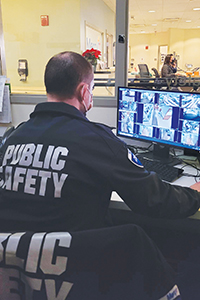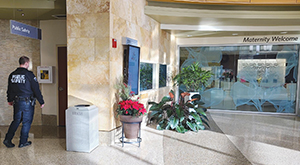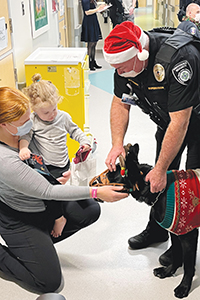By LISA EISENHAUER
Ann Schumacher says she wasn't surprised by what participants in the roundtable discussion that kicked off the work of the American Hospital Association's Hospitals Against Violence advisory group shared about incidents of violence in their health care facilities.

Schumacher
It validated that CHI Health Immanuel in Omaha, Nebraska, and CHI Health Mercy Council Bluffs in Iowa, hospitals she leads, were not alone in experiencing an upturn in aggression against staff in recent years and it reinforced her conviction that health care providers need to mount a coordinated effort to turn the tide of threats and physical violence against staff.
"It was incredible, the very difficult experiences these health care leaders have witnessed and been part of shootings on their campuses, assaults of their teams, loss of team members due to violence," she recalls of that virtual gathering in 2020. Schumacher, the president of the two CHI hospitals, was the only one of the nine participating health care executives from a Catholic system.

Public safety officer David Hensley looks over live feeds from security cameras mounted around the campus of Mercy Hospital St. Louis.
The advisory group's work led to the release in October 2021 of a compilation of resources to help health care leaders deal with and, ideally, reverse the rising trend in violence.
At least one other group of health care leaders, the CEO Coalition, was formed in recent months to address the medical sector's worsening trend of violence, borne out by case numbers gathered by the U.S. Bureau of Labor Statistics.
The coalition was created in early 2021 in partnership with the nonprofit Institute for Healthcare Improvement and https://www.vocera.com/, a company that makes mobile communications apps. Its goal is to create a national movement and action plan to safeguard the emotional and physical safety of health care employees and provide "the systems, tools, technologies, and resources they need and deserve to feel safe at work."
The coalition's founding members include two top executives from the Catholic health ministry: Laura Kaiser, president and chief executive of SSM Health and chair-elect of CHA's Board of Trustees, and Dr. Rod Hochman, president and chief executive of Providence St. Joseph Health, and a past chair of the CHA board.
"This is not an exclusive group," Kaiser says. "This is inclusive and we're inviting others to lean in. This is a goal that, just like with ending the COVID pandemic, we're all working toward."
A worsening trend
The relatively high incidence of violence in the health sector is not new. The U.S. Bureau of Labor Statistics reports an uptick that goes back at least to 2011. It notes that in 2018:
- Health care workers accounted for 73% of all nonfatal workplace injuries and illnesses due to violence.
- The incidence rate for nonfatal occupational injuries and illnesses involving days away from work due to intentional injury by another person was 10.4 per 10,000 full-time workers in the private health care or social assistance sector, compared to 2.1 for all full-time workers.
Health care leaders and organizations say violence has continued to worsen during the pandemic. A report called "Injury to None" released in February 2021 by the union National Nurses United said about 20% of the 15,000 nurses it surveyed reported an increase in workplace violence since COVID inundated hospitals.
Nurses attributed the increase "to multiple factors including decreased staffing levels, changes in patient population, and visitor restrictions," the report said.
More threats amid pandemic
Jason Grellner is executive director of public safety for Mercy, a health system based in suburban St. Louis with facilities in four states. Grellner says he has seen violence and threats spike in his four years with Mercy and especially since the start of the pandemic. Where before such incidents happened mostly in behavioral health units or emergency departments, he says they are now being reported in clinics and pharmacies.

A security officer enters a security office substation near the main entrance at Mercy Hospital St. Louis. The hospital has another substation near the busy entrance to its emergency department. The main security office is elsewhere on the hospital campus.
"One hospital has had three occasions in the last 12 months where individuals have threatened to come on campus with firearms and shoot multiple workers and we've had to involve local, state and even federal authorities in some cases," Grellner says. Even though none of those threats resulted in violence, he says the fear and uncertainty they induce add to the stress on health care campuses.
He suspects the rise in violence in health care facilities is related in part to a lack of community mental health resources. There are too few beds in drug rehab and behavioral health programs, he says. He also cited the normalizing of "street narcotics" such as marijuana, which can make some users more prone to violence; the shrinking pool of medical workers that results in overstretched staff; and the coarsening of dialogue and increased factionalism across U.S. society as contributing factors.
"We've had clinic spaces where people have threatened our staff because they were unhappy with service, because they were frustrated with their day," he says. "They took it out on our co-workers and what normally would have been 'I'm sorry, I'm having a bad day' becomes 'I'm going to assault you, spit on you, punch you.'"
Mercy, like many other health care systems, has taken a number of steps to deter and respond to violence. It has added security cameras so there are now more than 6,000 systemwide as well as panic alarms that staff can use to summon security officers; invested in or explored other technology such as robotics and geolocation systems; and expanded staff training on how to react in the event of an armed intruder and other threats.
"We want Mercy to be a safe place to work, a safe place to receive care, and a safe place to shelter when you can find no other safe place," Grellner says.
Pillars of safety
The Hospitals Against Violence advisory group is working to improve safety in health care facilities nationwide. The group helped the American Hospital Association craft a framework called "Building a Safe Workplace and Community" that is based on four pillars: a culture of safety at health facilities, mitigation of potential risks, violence intervention and trauma support. The board and the association developed resources around the framework that include an 11-page guide called "Creating Safer Workplaces," case studies, a podcast and a blog.
The initiative urges a number of practices on health care campuses, including creating policies to increase safety and educating staff on how to spot threats and training them on violence prevention.

Sarge the security dog and his handler Pat McKenna, part of the Providence K-9 Security Program, are dressed for the holidays as they make the rounds to spread cheer at Providence Sacred Heart Medical Center and Children's Hospital in Spokane, Washington.
Schumacher says another piece of the initiative is to collect and share data "so that we can understand better the depth and breadth of violence in health care as well as have the ability to start measuring outcomes for some of these interventions."
Part of what's driving the Hospitals Against Violence effort, she says, is a desire to take responsibility for and deliver on efforts to address violence. "I think by taking a stand the American Hospital Association and this advisory group are saying, 'We are accountable, we are going to come to the table and we are going to transform the workplace,'" Schumacher says.
The group is encouraging health care leaders to partner with their communities and with other organizations, such as the International Association for Healthcare Security and Safety, in their efforts.
Heightening awareness
The Hospitals Against Violence initiative and the CEO Coalition hope to draw more attention to the increasing risks faced by health care workers, spurring answers and action.
Kaiser says many people are surprised to learn that health care has a much higher prevalence of workplace violence than other sectors. That violent incidents are on the rise at SSM Health as at other health systems is tragic, she says.
The declaration of principles that Kaiser and fellow founders of the CEO Coalition drafted to guide their work lauds the "selfless acts of courage, care, and compassion" by health care workers during the pandemic. It also acknowledges the pandemic has "exacerbated the factors contributing to workplace violence, created an environment of unprecedented stress, and exposed the impact of systemic inequities and racial injustice on the well-being of healthcare team members."
A lead role for Catholic systems
The coalition's declaration urges developing and sharing strategies and best practices around the pillars of safeguarding psychological and emotional safety, promoting health justice and ensuring physical safety of workers.
Kaiser sees the coalition's focus on health justice as an aspect of improved security that aligns with CHA's We Are Called initiative to promote health care access and equity. It's an area of the coalition's effort where she believes the Catholic health ministry can play a lead role.
"Who better than Catholic health care to be in the midst of that work, asking for it, driving it, making it happen?" she asks.
Kaiser and Schumacher say that efforts to stem violence in health care workplaces need and deserve widespread public support.
Says Kaiser: "I think this is just the beginning of a much larger conversation and movement."
Security chief at CHRISTUS hospital relies on visibility, vigilance
Vern Rennier instituted some new practices at CHRISTUS St. Frances Cabrini in Alexandria, Louisiana, that he credits with improving security and reducing the risk of violence there. He did it without adding to the staff he's overseen since taking the job of security manager two years ago after retiring from the city's police force.

Rennier
His main change in tactics has been to increase his team's visibility on the hospital campus. One way he has done that is by dividing the campus into zones and assigning security officers to cover them in three-hour stints. "They go in, make checks, sign books to confirm that they did the security rounding," he says.
Then, the officers shift to a different zone. That switch increases the chance that staff, patients and visitors see more than one uniformed security person.
One of the zones is the hospital's parking areas. To patrol them, the security team added a cruiser that looks like those used by police. The officer driving it keeps its blue and red lights on, but not flashing. Rennier says that before those patrols began, cars on the hospital lots were frequent targets of burglars. In the last two years there has only been one car burglarized and it was an unlocked vehicle.
He and his team also check in with the staff in the units to hear concerns about potential threats. If any are identified, Rennier says, they increase their rounding. "What we've noticed, since we've done that, is we have less and less incidents that occur," he says.
Rennier notes that the COVID-19 pandemic has brought new stressors, including visitation limits and mask mandates, that at times have heightened tension on the hospital campus. He and the hospital's leaders have looked for simple ways to defuse that tension. One practice they started is to have security officers carry a baggie of face masks. When someone challenges masking rules, the officers politely explain that face coverings are a health care mandate and offer them one.
"We haven't had any issues," he says. "We haven't had to escort anybody off our premises or anything like that since."
Rennier says the new practices have given hospital staff a stronger sense of security. One new nurse told him that as she was weighing job offers, her sense that St. Frances Cabrini was safer than the other hospital in Alexandria proved to be the deciding factor.
"That was a pretty awesome story to hear from someone that was why they chose to come to work here," Rennier says.
He adds: "Our security team at CHRISTUS St. Frances Cabrini is equipped with great de-escalation training and has been given the tools to be successful."
— LISA EISENHAUER